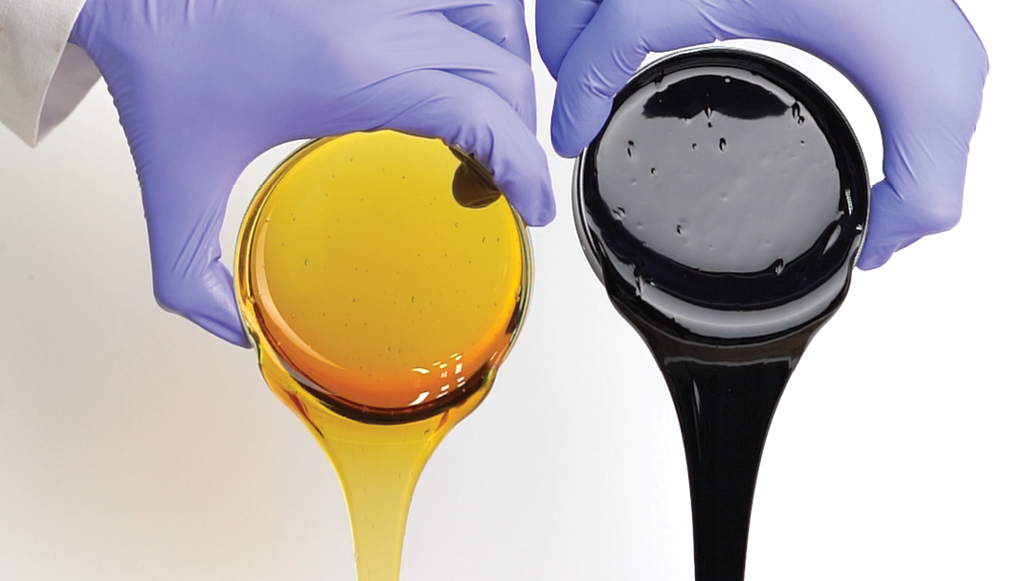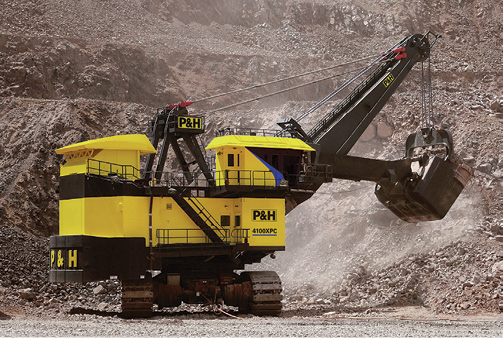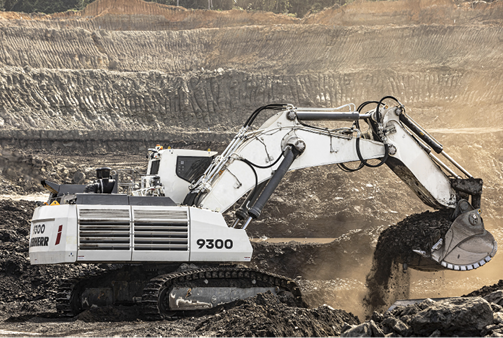North American Mining examines the world of biodegradable lubricants and their role in reducing the environmental impact of mining.
by Jonathan Rowland

In a “fast-changing world where environmental issues have become central, mining companies need to assess all pollution sources that may come from their operations,” began Guillaume Bonnetot, general manager of Systems at Liebherr Mining. “Among these, contamination of soil and groundwater by lubricants are areas for improvement.”
This contamination is problematic “due to its toxicity and ability to accumulate in the environment,” explained Adam Kropp, senior product and strategic marketing manager at fellow heavy mining equipment supplier Komatsu. “Even when managed responsibly, some lubrication loss is possible while open gear lubricants (OGLs) are, by design, exposed to the environment. Unintended spills, line breakages, and fitting failures can trigger costly remediation efforts and time-consuming reporting protocols.
Due to their asphalt-based composition, OGLs are a notable challenge, as they often contain heavy metals such as lead, zinc, and cadmium. “While effective in protecting large gears under extreme loads, the environmental impact of these metals is a significant concern,” said Oscar Castro, manager of Applications Engineering at lubricants supplier Interlub.
“Heavy metals are particularly persistent in the environment, accumulating in ecosystems and degrading water and soil quality. Direct contact can be lethal to or severely disrupt the reproduction and development of aquatic species. Heavy metals can also accumulate in food chains, with larger predators experiencing the highest concentrations, a process known as biomagnification.”
This may lead mining companies to consider switching to biodegradable lubricants, which reduce “the risk of soil and water contamination,” said Dr. Neil Canter, president of Chemical Solutions, a specialist lubrication consultancy. “Federal or local regulations could require this, or it might form part of the company’s environmental policies.”

What is a biodegradable lubricant?
The basic premise of a biodegradable lubricant is (as the name implies) one that “naturally decomposes through the action of microorganisms in a suitable environment, breaking down into less harmful substances like water, carbon dioxide, and biomass,” explained Castro. “A key challenge is that not all biodegradable lubricants are the same: the rate and completeness of their decomposition can vary. Defining and standardizing these products is complex because it requires rigorous testing in different environments and the creation of standards that are clear and applicable globally.”
However, at the moment, there is “no universal definition of what constitutes a biodegradable lubricant,” said Brandon Richards, business manager for Biodegradables – Americas at fellow lubrication supplier Shell.
“There are multiple standards linked to biodegradable fluids,” said Liebherr’s Bonnetot. “These are not necessarily uniform. As a result, some fluids are biodegradable or partially biodegradable according to one standard but not another, which does not make it easy to understand the whole picture. Additionally, for some lubricants (e.g., greases), only part of the product’s composition is assessed for biodegradability rather than the entire product, which may call into question the relevance of the approach.
“Finally, other approaches are emerging to classify biodegradable lubricants that attempt to cover a multitude of criteria, such as biodegradability and bio-accumulative potential, exclusion or limitation of hazardous substances, toxicity, renewable ingredients requirements, and packaging.”
Despite this somewhat confusing situation, our contributors mentioned several current standards as noteworthy:
- The OECD’s 301B chemical test guidelines for ready biodegradability state that >60% of the fluid biodegrades under aerobic conditions within 28 days.
- The U.S. EPA’s Vessel General Permit (VGP) regulations set Environmentally Acceptable Lubricants (EAL) parameters.
- The USDA’s Biopreferred program measures bio-based content using a radioisotope test method (ASTM D6866).
In addition to being biodegradable, Interlub’s Castro suggested three other factors in creating an EAL or biolubricant: formulation from renewable raw materials; non-toxic to the environment and human health; and high-performance, offering superior performance in its application, reducing consumption and carbon footprint. “Opting for a biodegradable lubricant is a good step, but a biolubricant is the optimal goal.”
As to the ingredients of biodegradable lubricants, the primary feedstocks include vegetable oils (e.g., canola, sunflower, or soybean), synthetic esters, polyalkylene glycols (PAG), or polyalphaolephins. “The performance of plant-based oils is not generally as good as biodegradable lubricants made from synthetic oils, as indicated by performance properties like oxidation resistance, thermal stability, and hydrolytic stability,” commented Shell’s Patrick Odneal, industrial lubricants marketing manager.
Genetic engineering is “beginning to play a role in this area,” added Castro, “particularly in optimizing plants that produce the base oils, improving their resistance to extreme conditions or oxidative stability. Although we are still in the early stages, these improvements could make biodegradable lubricants more efficient in demanding applications like mining.” Genetic engineering is “one recent aspect that can contribute to the improvement of biodegradable products,” agreed Liebherr’s Bonnetot. “However, this needs to be qualified regarding the high requirements specific to most industrial applications.”
Carbon nanotubes and graphene also have the potential to “revolutionize biodegradable lubricant performance,” said Interlub’s Castro. “These materials enhance wear resistance and thermal stability, two areas where biodegradable options have traditionally faced limitations. These advancements allow biodegradable lubricants to withstand more extreme conditions without compromising their ability to break down in the environment.” Although, their use in biodegradable lubricants is still in its “early stages,” noted Shell’s Richards. “It could be exciting to monitor developments in genetic engineering in the coming years.”

Photo: Interlub.
Testing lubricant performance
Various tests measure lubrication performance, evaluating parameters including (but not limited to) oxidation resistance, thermal stability, wear resistance, weld load, corrosion resistance, pour point, flashpoint, hydrolytic stability, elastomeric compatibility, and viscosity index. Biodegradable lubricants “can display comparable performance to petroleum-based products in these tests, but lubricant manufacturers need to formulate them differently,” said Canter. “As an example, some biodegradable lubricants are more vulnerable to oxidation. Depending upon the application, several types of antioxidants may be required, possibly at higher treatment rates.”
“Generally speaking, premium biodegradable lubricants can meet requirements comparable to petroleum-based products,” added Bonnetot. “However, certain specific features, such as high temperatures and water ingress into circuits and components, can degrade biodegradable lubricants’ performance and attenuate their operation performance. On the other hand, as biodegradable fluids are synthetic-oil based, their low-temperature performance is advantageous, with generally favorable characteristics compared with petroleum-based lubricants.”
Overall, the goal is to “protect the machinery not just on Day One, when the lubricant is new, but to provide reliable protection for the life of the lubricant,” concluded Shell’s Richards.
“It is important to understand that not all biodegradable lubricants perform the same. Many low-quality biodegradable lubricants do not provide the long-life protection that a petroleum-based oil provides. That is why using
a high-quality biodegradable lubricant is essential to ensure you do not sacrifice the machine’s life.”
Economics of switching to biodegradable lubricants
Without specific regulations requiring them for surface mining, “biodegradable lubricant demand is still relatively low,” said Komatsu’s Kropp, “while to develop these oils, suppliers need financial support and technical resources for testing and validation. Further, the development cost is high, meaning the new lubricants will cost more than traditional ones, especially at the outset.” Biodegradable lubricants based on synthetic oils are “systematically more expensive, typically by a factor of two or three, than petroleum-based lubricants,” agreed Liebherr’s Bonnetot. “This difference can be explained not only by the degree of complexity involved in formulating these products but also by the small quantities produced worldwide compared to mineral-based products.”
While acknowledging this, other contributors pointed to potential reductions in the total life of ownership achievable by synthetic biodegradable lubricants. “From a total cost of ownership, synthetic base stocks usually will display better performance over a longer period,” said Canter. “This may reduce the initial cost advantage of petroleum-based lubricants.”
“It’s important to consider factors such as oil life, energy efficiency, and cold-start protection, which are domains where high-quality biodegradable lubricants shine,” added Shell’s Odneal. “The fuel costs and the electricity bill at a typical mine far exceed the amount spent on lubricants. Higher-quality lubricants usually have lower coefficients of friction and better density properties, which can save on fuel (such as in mobile equipment) or electricity (such as in fixed-plant equipment), bringing cost savings compared to the use of mineral oils.”
According to Interlub’s Castro, there are additional long-term advantages, too, considering “the total cost of ownership, which includes factors such as reduced environmental fines, lower contamination risks, reduced waste disposal costs, and improved operational sustainability. Some modern biodegradable lubricants also offer longer lubrication intervals, reducing downtime and maintenance costs.”
However, differences in the total cost of ownership are challenging to quantify, as many factors can influence the longevity of a fluid in its application, not just the fluid itself, noted Bonnetot. “Total cost of ownership is also dependent on the application. Whether a mining company should use a biodegradable lubricant will ultimately depend on the specific mining application,” added Canter.
Operational considerations
“The first point to note is that biodegradable fluids are generally incompatible with petroleum-based oils,” explained Liebherr’s Bonnetot. “This involves several precautions and changes in operating processes. For example, converting a machine to a biodegradable lubricant may require complete drainage of the system or component and appropriate flushing to limit the oil mix, sometimes to below 2%.
“Similarly, there must be no mixing during maintenance operations (e.g., oil change or top-up) to avoid accidentally filling biodegradable oil into a system using petroleum-based oil or vice versa. Mining companies must ensure adequate training of maintenance personnel and adapt equipment (e.g., service truck or filling station at the workshop) to reduce the risk of accidental mixing.”
“Like any good preventative maintenance program, oil condition monitoring is essential,” added Shell’s Richards. “Oil analysis can confirm the removal of petroleum-based oil. Additionally, by analyzing oil on a routine basis, mining companies can help predict the remaining useful life of the oil and catch any contaminants that have entered the system.”
“Under certain operating conditions (e.g., high humidity) and depending on the chemistry used in the biodegradable lubricant, more regular oil analyses should be carried out to assess the evolution of the biodegradable lubricant,” commented Bonnetot. “Additional bypass filtration with water separation and absorption may also be mandatory. Finally, it is important to consider the compatibility of certain biodegradable products with rubber or certain yellow metals components.”
While biodegradable lubricants offer “a significant advance in reducing environmental impact, they still require proper handling and management,” noted Interlub’s Castro. “The fact that they decompose more quickly does not exempt them from careful handling to maximize their efficiency and ensure their correct use. Personnel must be aware that, although these lubricants are more environmentally friendly, they must be stored and applied responsibly.”
This responsibility also extends to their disposal, as biodegradable lubricants “require specific conditions for effective decomposition,” continued Castro. “For degradation to occur, they must be in a controlled environment with microorganisms, appropriate temperature, and humidity. It may delay degradation if these conditions are not present. Storage and final disposal thus require the same diligence as traditional lubricants.”
Finally, Bonnetot highlighted a distinction between fluids intended to remain in a system (e.g., closed hydraulic circuits or gears) and fluids systematically released in the environment (e.g., greases for continuous lubrication of pins and bushes).
“We should focus efforts to introduce biodegradable lubricants on the latter, as these products will ultimately always end up in contact with the environment. However, in the case of closed systems and components, certain maintenance operations or accidental leaks may involve the release of fluid into the environment, which can justify using biodegradable fluids.”

Regulation and biodegradable lubricants
Regulations requiring biodegradable lubricants, such as those for large vessels operating in the Great Lakes and near the coastal U.S., are limited for mining. “Some effluent guidelines exist in Canada, and the State of Montana requires biodegradable lubricants and solvents in some mining conditions,” noted Kropp. “However, surface mining operations are largely unregulated in this area.”
That is not to say that regulations and policies are not playing a role in inching the industry toward more environmentally responsible lubrication practices.
“Canadian and American regulators are encouraging the use of biodegradable lubricants through policies aimed at reducing the environmental footprint of industries,” said Interlub’s Castro.
“These force mining operations to consider their practices and adopt more sustainable ways, partly to comply with legislation and avoid penalties, but also due to pressure from investors and public opinion.”
Future trends
In addition to genetic engineering and carbon nanotubes/graphene, Shell’s Richards pointed to two trends where he expects development in using biodegradable lubricants. “The overlap of energy efficiency and biodegradability is an exciting domain,” he noted. “These fluids are available on the market today, with their energy efficiency gains widely tested. Some easy wins include PAG lubricants in worm gearboxes and low-density hydraulic fluids, giving instant fuel or electricity cost savings.”
Another “exciting domain is dielectric cooling of battery-electric equipment,” continued Richards. “We have developed cooling fluids for immersion cooling batteries, switches, and other electrical components. Using a dielectric oil, unlike water, allows for direct contact, which gives better heat-transfer properties. These fluids are PFAS-free and readily biodegradable.”
“We can expect to see greater development of specialized biodegradable lubricants for extreme conditions and using more innovative renewable sources, such as algae or microorganisms,” concluded Castro. “Continuous improvement in additives and high-performance formulations will also drive the adoption of biodegradable lubricants, while advancements in measuring and certifying biodegradability will allow companies to select products more accurately for their needs.”
However, for their benefit, a note of caution is needed. “We will only see increased biodegradable lubrication use in North American mining and mineral processing operations if more regulations require them or if they become price competitive with petroleum-based lubricants without sacrificing performance,” concluded Canter.
